Journey into the biblical landscape to uncover the hidden significance of wadis, where water and wisdom flow in the arid wilderness.
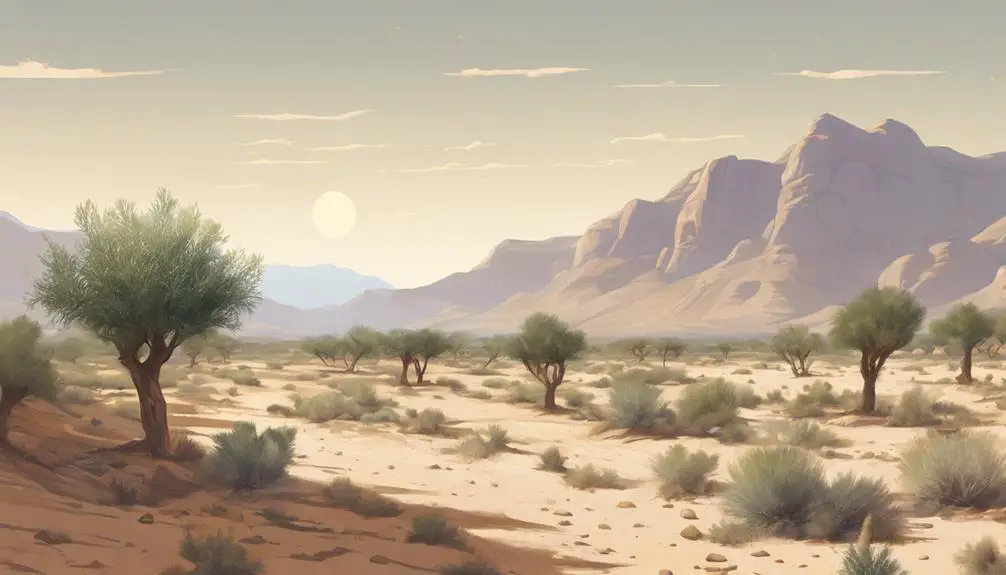
What Is a Wadi in the Bible
Imagine walking through a dry, rugged landscape, and suddenly, you stumble upon a wadi, a seasonal riverbed that breathes life into the arid regions mentioned throughout the Bible. You've probably glossed over this term, but its significance in biblical narratives is more profound than you might initially think.
Wadis served not just as physical landmarks but also carried deep symbolic meanings, impacting agriculture, travel, and the very survival of ancient communities. As we explore the multifaceted roles of wadis, you'll uncover how these natural phenomena shaped stories, metaphors, and the daily lives of biblical times, inviting you to reconsider their overlooked significance.
Key Takeaways
- Wadis are dry riverbeds that become filled with water during seasonal rains, mentioned in biblical contexts.
- In the Bible, wadis symbolize both the challenges of desert life and divine provision in times of need.
- These geographical features serve as settings for various biblical narratives, including military and spiritual lessons.
- Wadis reflect the significance of water management and climate adaptation in ancient Near Eastern societies.
Definition and Origins
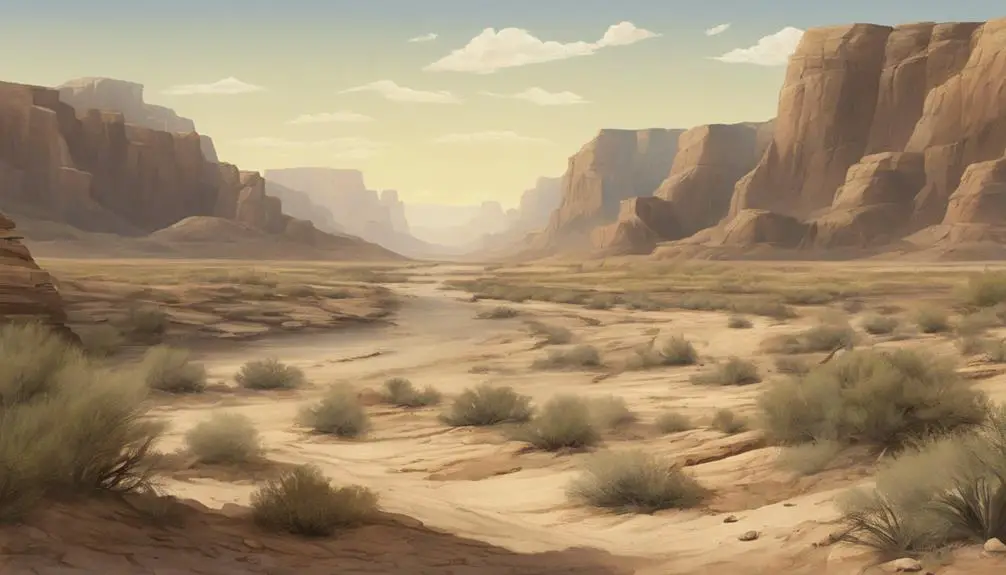
In biblical contexts, a wadi denotes a dry riverbed or valley that temporarily fills with water during seasonal rains, originating from the Arabic term 'wādī,' which reflects its significant geographical and cultural implications in the Near Eastern landscapes. The formation of these transient watercourses is deeply intertwined with the climatic influences characteristic of arid and semi-arid regions, where rainfall isn't only scarce but also highly unpredictable.
You'll find that the creation and evolution of a wadi are largely dependent on such climatic conditions, which drive the episodic and often intense hydrological processes necessary for their development. During the rare but heavy rainfalls, these dry valleys transform, channeling the sudden influx of water towards lower elevations. This process, though brief, plays a critical role in shaping the landscape, carving out the wadi's path through sediment transport and erosion.
Moreover, the formation processes of wadis are indicative of the delicate balance within these ecosystems. The sporadic nature of rainfall in these regions requires an understanding of the complex interplay between surface water flow and the geomorphological characteristics of the terrain. As such, the study of wadis offers invaluable insights into the broader environmental dynamics at play, including soil erosion, sedimentation, and the recharge of aquifers—elements that are crucial for sustaining life in these challenging environments.
In essence, the genesis and persistence of wadis are a testament to the adaptability of natural landscapes to the climatic extremes prevalent in the Near East, underscoring the importance of these features not just in biblical narratives but also in the understanding of ancient and contemporary environmental processes.
Geographical Significance
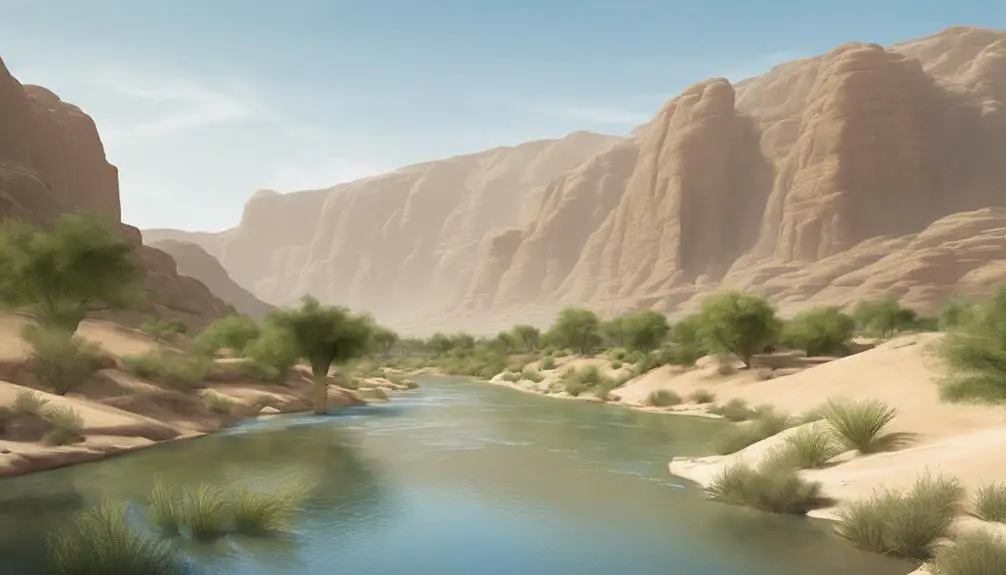
Wadis hold a pivotal role in structuring the socio-economic and environmental landscapes of Near Eastern regions, shaping not only the physical geography but also the livelihoods of communities that have historically depended on these ephemeral water sources. You'll find that these natural features are not merely scenic, but they're instrumental in the way people adapt to the climate and manage their resources. The interplay between wadis and human settlements is a testament to the resilience and ingenuity of these communities in the face of harsh environmental conditions.
Understanding the geographical significance of wadis also means delving into how they influence erosion patterns. The sudden and powerful flow of water during rainy seasons carves out the landscape, creating fertile valleys in its wake but also posing challenges for managing soil erosion. This dynamic shapes agricultural practices and settlement patterns, as communities must navigate the balance between harnessing the benefits of wadis and mitigating their destructive potential.
Factor |
Impact on Wadis |
|---|---|
Climate Adaptation |
Shapes human and ecological responses to environmental variability |
Erosion Patterns |
Influences landscape formation and agricultural viability |
Water Availability |
Determines settlement patterns and socio-economic activities |
Biodiversity |
Supports unique ecosystems adapted to intermittent water flow |
In this context, you'll appreciate that wadis are more than just temporary watercourses; they're central to understanding human-environment interactions in the Near East. Their presence and the challenges they present have been key drivers of innovation in climate adaptation strategies, shaping the region's culture, economy, and architecture for millennia.
Wadis in Biblical Narratives
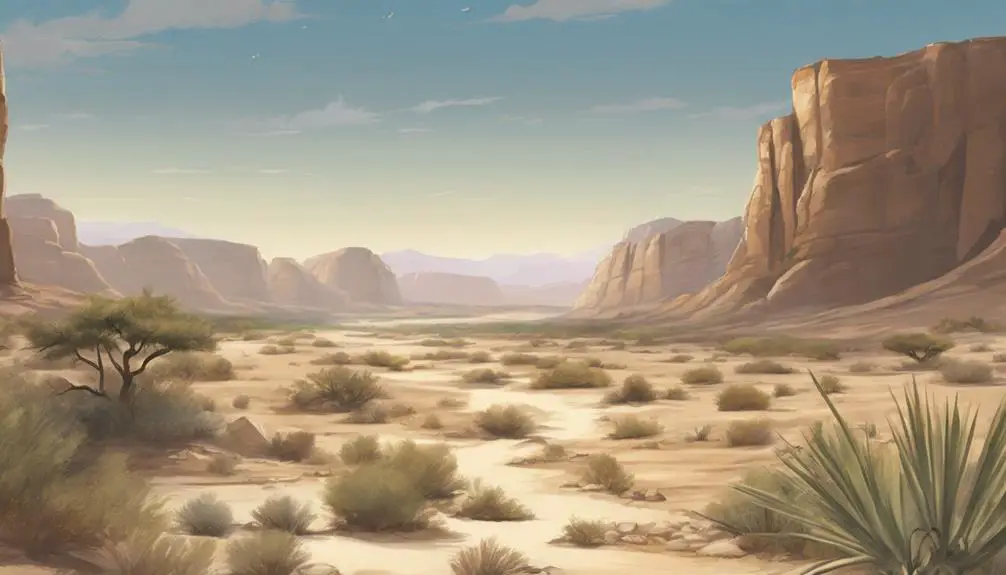
Throughout biblical narratives, you'll encounter numerous instances where wadis serve not only as physical settings but also as profound metaphors for spiritual and moral lessons, highlighting their significance in these ancient texts. These dry riverbeds, often transforming into desert oases during rainy seasons, symbolize both the harsh realities of life in the desert and the provision of God in times of need. They're not just geographical features; they're integral components of the stories that unfold within the Bible, providing a vivid backdrop against which the drama of faith, survival, and divine intervention is played out.
In the context of historical battles, wadis frequently appear as strategic elements in military narratives. Their unpredictable nature could either offer an unexpected advantage or pose a significant threat, depending on the season and the knowledge of the land held by the opposing forces. For instance, a wadi might be a concealed route for a surprise attack or a natural defense against an advancing enemy. These scenarios underscore the importance of understanding and respecting the natural landscape, a lesson that resonates well beyond the biblical era.
Analyzing these narratives, it's clear that wadis were more than just scenic backdrops or obstacles to be navigated. They were, in many ways, characters in their own right, influencing the course of events and shaping the spiritual landscape of the Bible. Through their presence in these stories, wadis teach us about resilience, reliance on divine provision, and the significance of the natural world in our spiritual journey.
Symbolism and Metaphors
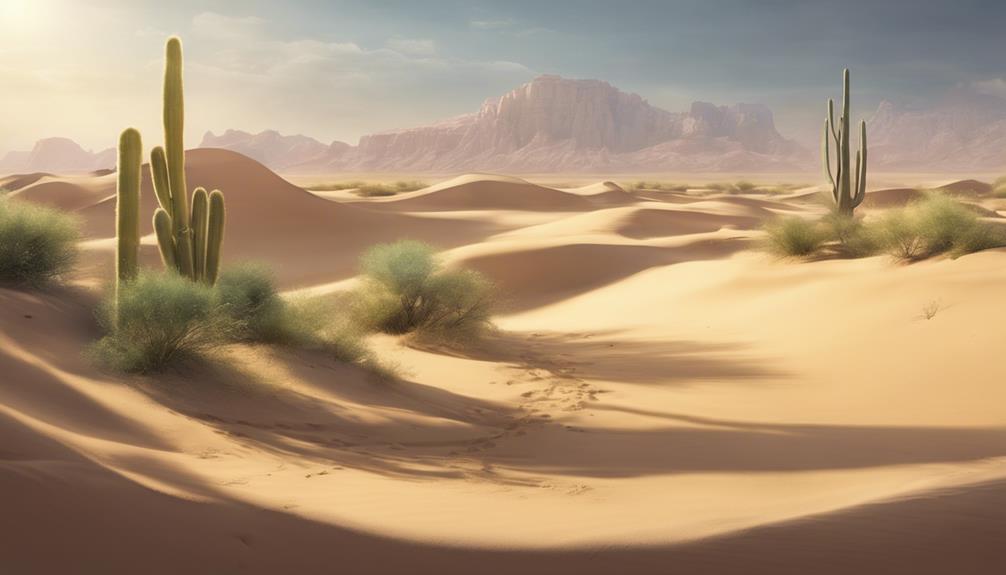
Reflecting on the narratives, it's evident that wadis aren't merely physical entities but also embody profound symbolic meanings and metaphors within the biblical text. These watercourses, often dry and appearing barren, transform into sources of life after rains, serving as powerful symbols of spiritual renewal and divine provision. The contrast between the arid stretches and the sudden flourish of life in a desert oasis mirrors the spiritual journeys depicted in the Bible, emphasizing themes of hope, rejuvenation, and the faithfulness of divine intervention.
Symbolism |
Interpretation |
|---|---|
Desert Oasis |
Represents spiritual refuge and divine provision in times of need. |
Seasonal Transformation |
Symbolizes the possibility of change and spiritual renewal. |
Dry Versus Flourishing States |
Illustrates life's cyclical nature and the promise of revival. |
Isolation |
Serves as a metaphor for periods of spiritual solitude, leading to growth. |
Water in the Desert |
Highlights the unexpected and miraculous ways God provides for His people. |
Through these symbolic representations, wadis become more than mere geographical features; they are imbued with deep spiritual significance. They teach the reader about resilience, reminding us that even in the most barren seasons of life, there exists the potential for growth and renewal. As you delve into the biblical text, you'll find that these metaphors enrich your understanding, painting a vivid picture of the spiritual landscape that frames the human relationship with the divine. The symbolism of wadis, therefore, not only enhances the narrative but also invites reflection on the broader themes of faith, provision, and transformation.
Impact on Agriculture and Travel
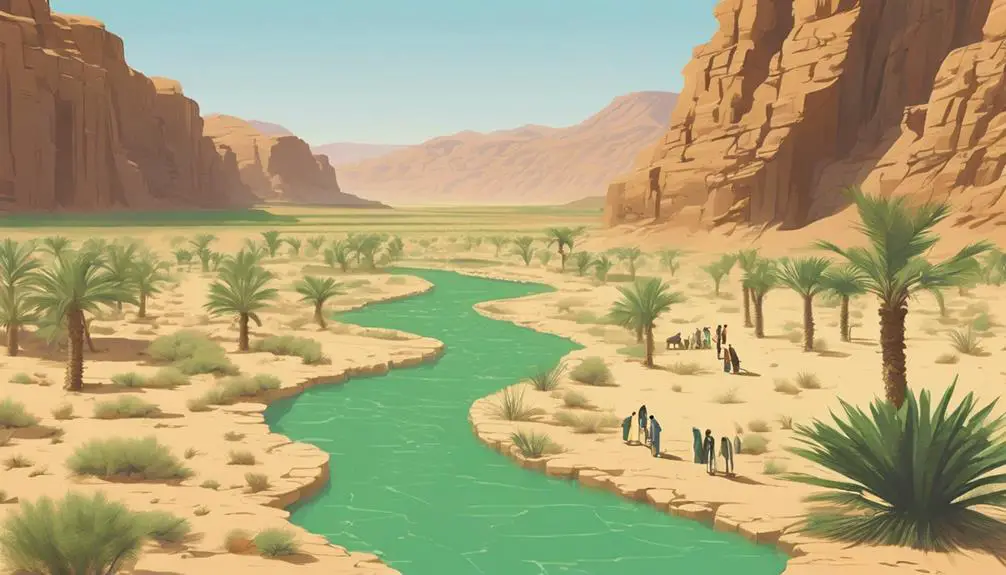
In examining the biblical landscape, it's clear that wadis significantly influenced both agricultural practices and travel routes, shaping the daily lives and economic activities of ancient communities. These natural channels, which filled with water during rainy seasons, were pivotal in the development of water management systems. Ancient peoples harnessed these unpredictable water sources through ingenious methods, ensuring the irrigation of crops in an otherwise arid environment. This mastery over their environment allowed for the cultivation of essential crops and the sustenance of livestock, which were integral to the survival and prosperity of these communities.
Moreover, wadis also acted as natural corridors through the rugged terrain, guiding the paths of caravan routes. These routes weren't only vital for the internal exchange of goods but also facilitated trade with neighboring regions. The passage through wadis enabled the transport of agricultural products, spices, and other goods, connecting distant communities and fostering economic and cultural exchanges. The strategic importance of these routes can't be overstated; they were the lifelines of commerce and communication in a landscape that could otherwise be harsh and isolating.
However, reliance on these natural channels wasn't without its challenges. The seasonal nature of wadis meant that water management was a constant concern, and travel routes could be abruptly altered or obstructed by the sudden onset of flash floods. Despite these hurdles, the ingenious adaptations and resilience of ancient peoples ensured that wadis remained integral to the agricultural and economic fabric of biblical times, underscoring their enduring significance in the historical and cultural narrative of the region.
Archaeological Discoveries
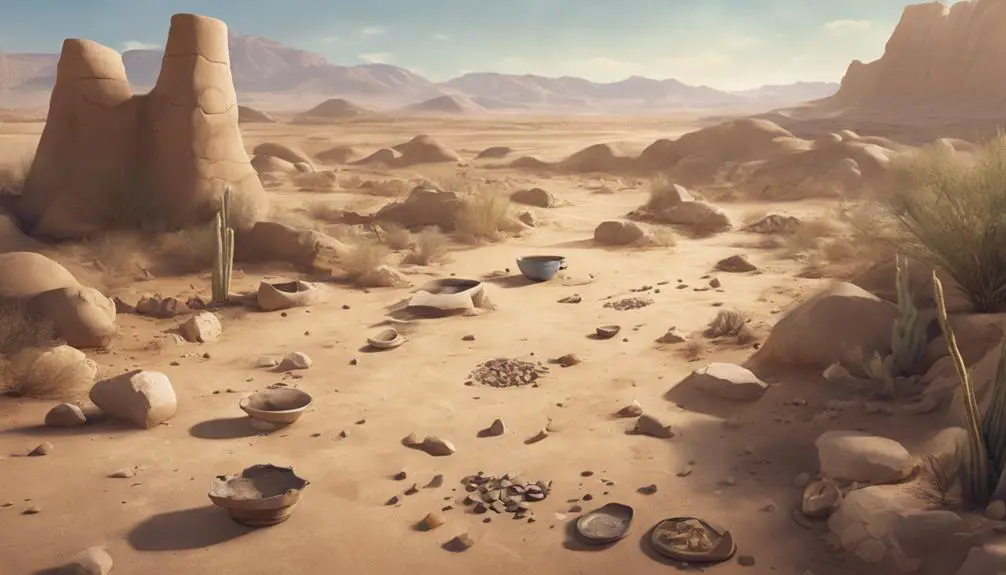
Recent archaeological excavations have unearthed evidence that further illuminates the role of wadis in the ancient Near Eastern societies mentioned in the Bible. These findings, comprising a variety of ancient artifacts, serve as a testament to the dynamic human activities that once thrived in these now arid channels. You'd be fascinated to learn how preservation techniques have played a crucial role in maintaining the integrity of these artifacts, allowing us a glimpse into the past.
Discovery |
Significance |
|---|---|
Pottery Shards |
Offer insights into the daily life, trade, and pottery-making techniques of ancient communities. |
Agricultural Tools |
Highlight the importance of wadis in ancient agriculture and irrigation practices. |
Religious Artifacts |
Suggest the spiritual significance of wadis, possibly as sites for rituals or offerings. |
Inscriptions |
Provide direct evidence of historical events, trade relations, and societal structure. |
The strategic importance of wadis, as evidenced by these discoveries, cannot be overstated. You'll notice that the preservation techniques, ranging from meticulous excavation to advanced conservation methods, have been instrumental in protecting these treasures from the ravages of time and the environment. This careful preservation ensures that each artifact tells a story, contributing to a larger narrative about the complexities of life surrounding these natural watercourses.
In analyzing these archaeological discoveries, it becomes clear that wadis were more than just physical landmarks. They were vital components of the social, economic, and spiritual fabric of the communities that lived alongside them. Through these ancient artifacts, we're offered a rare window into the sophisticated ways in which human societies adapted to and interacted with their environment, underscoring the wadis' significance in the biblical landscape.
Frequently Asked Questions
How Do Contemporary Environmental Issues Affect Wadis in the Middle East, and What Implications Might This Have for Historical Biblical Interpretations?
You're examining how environmental issues, notably climate resilience and water scarcity, impact wadis in the Middle East. These challenges can alter the region's landscape and water availability, potentially reshaping interpretations of historical and biblical contexts.
As wadis face increased threats, it's vital to consider how these changes might influence our understanding of ancient texts and the environmental wisdom they encapsulate, urging a reevaluation of historical narratives in light of current ecological realities.
Have Any Significant Cultural Practices or Traditions Developed Around Wadis in Modern Times That Differ From Their Biblical Contexts?
Yes, you've hit the nail on the head asking about modern practices around wadis. Today, wadi festivals have become significant, blending cultural celebrations with spiritual symbolism that goes beyond their biblical contexts.
These events often emphasize community unity and environmental stewardship, marking a departure from purely historical or religious interpretations. They've developed into occasions where tradition and modernity meet, showcasing how cultural practices can evolve while still honoring their ancient roots.
In What Ways Have Advancements in Technology Altered the Exploration or Understanding of Wadis Mentioned in the Bible?
Advancements in technology, particularly remote sensing and archaeological drones, have revolutionized your understanding of wadis. These tools allow you to explore and analyze these areas with unprecedented detail and accuracy, uncovering hidden features and historical insights that were previously inaccessible.
Can Parallels Be Drawn Between the Role of Wadis in Biblical Times and Similar Geographical Features in Other Ancient Civilizations' Texts and Myths?
Imagine stepping into a world where rivers vanish under the sun's gaze, similar to the wadis of old. In your quest, you'll find that ancient civilizations also whispered tales of these ephemeral streams.
Analyzing wadi symbolism alongside ancient comparisons reveals a shared narrative thread—water as life and transformation. Through scholarly eyes, you'll see how these geographical features sculpted not just landscapes, but the very fabric of ancient myths and realities.
How Do Different Translations of the Bible Handle the Term "Wadi," and Does This Affect the Interpretation of Passages Where Wadis Are Mentioned?
You'll find translation consistency of 'wadi' varies across Bible versions, leading to interpretive challenges. Different translations might use 'valley,' 'stream,' or 'ravine,' affecting how you understand passages mentioning wadis.
This inconsistency requires you to delve deeper into the context and original languages to grasp the full meaning. It's crucial for a scholarly analysis, ensuring you're not missing nuanced interpretations tied to the geographical and cultural significance of wadis in biblical times.
Conclusion
In conclusion, wadis have significantly shaped the narratives and landscapes of the Bible, intertwining with its stories and symbolisms. These ephemeral watercourses, crucial for agriculture and travel, highlight the adaptability of ancient communities to their environment.
Interestingly, over 1000 wadis have been identified in the biblical lands, underscoring their prevalence and importance. This statistic not only captivates but also underscores the profound impact of these natural features on the development and sustenance of early civilizations in biblical times.


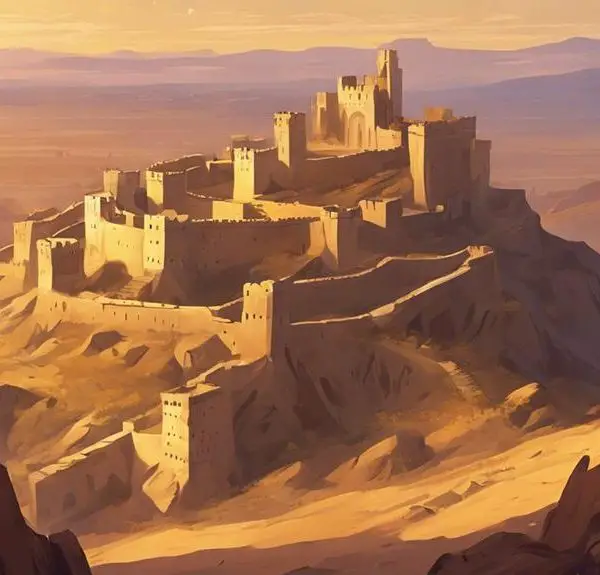
Sign up